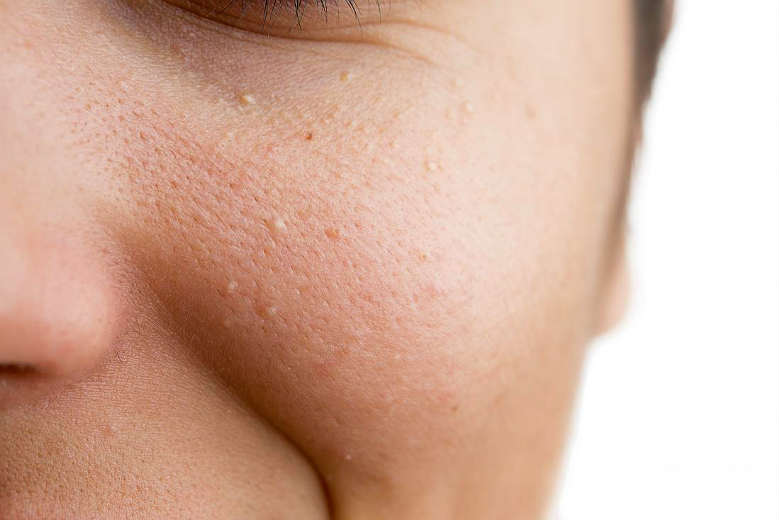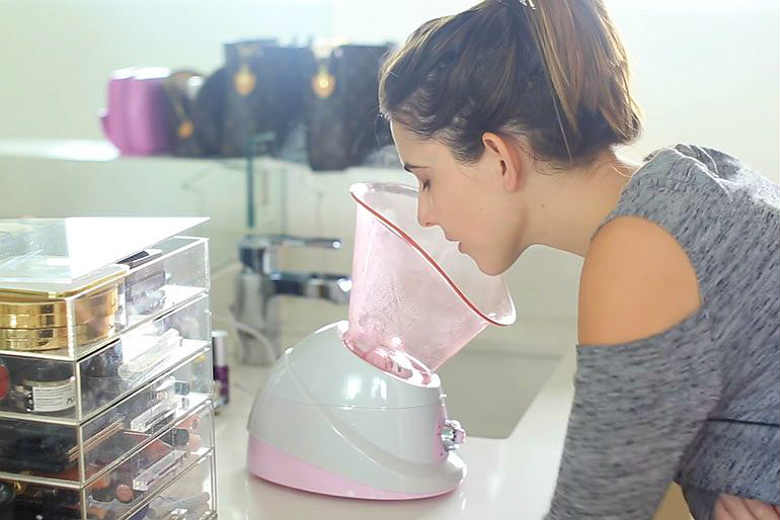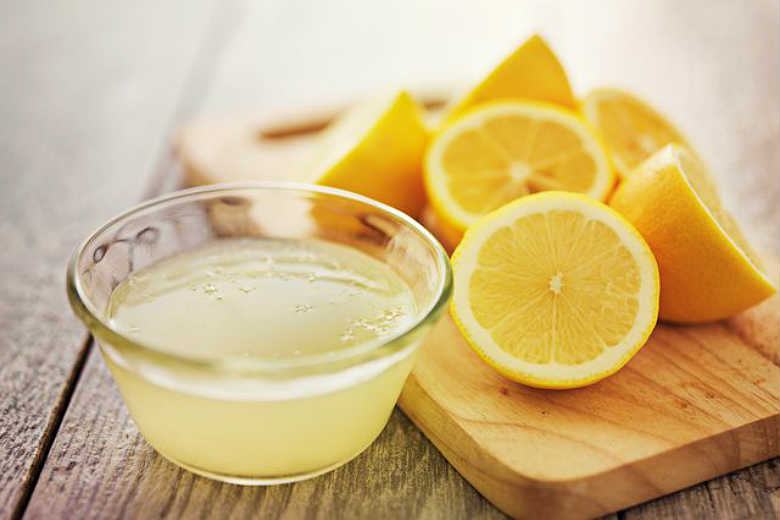Glowing and flawless skin is the dream of every woman. But no matter how much we care for our skin, some ‘mysterious’ issues keep haunting us! One of them is ugly white and hard spots all over the facial skin. If you notice carefully, you may find those ‘tiny monsters’ on your eyelids, around your eyes, or even your cheeks. Well, we are talking about oil bumps. These unsightly spots may not be harmful to you but can come in the way of your beautiful appearance. So, here is everything that you need to know about them, along with several natural remedies and other techniques to get rid of oil bumps.
What Are Oil Bumps?
Oil bumps are medically termed as ‘milia‘ or ‘milium cysts’ or ‘milk spots.’ These are tiny, dome-shaped ‘cysts’ or bumps 1-2 mm. in size and white or yellowish. They are typically found in clusters on different parts of the face like the forehead, eyelids, undereye area, nose, cheeks, and lips. But they can appear on other body parts, including the torso and genitalia. Oil bumps are cysts filled with keratin protein, usually formed when the protein gets trapped underneath the skin’s surface. Unlike pimples, these hard bumps refuse to burst but are not itchy, painful, or harmful. They only look ugly if you have many of them and can cause discomfort when touched with any cloth or sheet of rough texture. However, natural home remedies and specific medical treatments can remove them quickly.
Though oil bumps are most common in newborns (often mistaken for ‘baby acne’), they can affect people of any age or ethnicity.
Read Also – These Skincare Tips After Threading Face Will Save You From Acne, Bumps, And Whiteheads
What Causes Oil Bumps?
The exact causes of oil bumps in newborns remain unknown. However, in older individuals, these bumps are primarily attributed to the keratin protein becoming trapped under the skin due to skin damage. Conditions such as epidermolysis bullosa (EB), cicatricial pemphigoid, porphyria cutanea tarda (PCT), injuries like burns or poison ivy rashes, prolonged exposure to sunlight, use of steroid creams, and skin resurfacing procedures (laser resurfacing, microdermabrasion) can lead to the development of oil bumps. Additionally, aging contributes to oil bumps as the skin loses its natural exfoliation ability.
Also Read – What are Freckles on Lips? Know the Causes, Risks, and Remedies
Different Types Of Oil Bumps
According to the causes lying behind, oil bumps or milium cysts can be divided into the following categories (1):
1. Neonatal Milia
Neonatal Milia affects almost 40% of all newborns in America. Found on the face, nose, inner mouth, upper trunk, and scalp of newborns, these bumps are usually present from birth and disappear on their own just within a few weeks. They are all similar in size, with no redness around them.
Neonatal Milia are different from Neonatal Acne, which are white bumps of variable sizes with prominent redness surrounding them.
2. Primary Milia
In Primary Milia, those tiny cysts are found mostly on and around the eyelids, forehead, nasal crease, cheeks, and genitals. It can occur in both children as well as adults and can take from a few weeks to several months to disappear without treatment.
3. Juvenile Milia
Juvenile Milia is caused by rare genetic disorders that negatively impact the skin. Some of them include Nevoid Basal Cell Carcinoma Syndrome (NBCCS), Pachyonychia congenita (PC), Gardner’s syndrome, and Bazex-Dupré-Christol Syndrome (BDCS). However, it is not very common.
4. Milia En Plaque
In this type of milia, multiple bumps are clumped together to form a wide, flat patch or plaque with a clear or defined border elevated above the adjacent skin. It appears on eyelids, cheeks, jaw, behind the ears, etc., and is occasionally associated with genetic or autoimmune skin disorders like pseudoxanthoma elasticum, discoid lupus erythematosus, and lichen planus. Though it mainly occurs in middle-aged females, this condition can also affect others.
5. Multiple Eruptive Milia
It is another rare type of milia in which numerous cysts appear together in the same area over some time (from several weeks to months). It can be found on the face, upper arms, and torso, which often feel itchy.
6. Traumatic Milia
Traumatic Milia, also known as Secondary Milia, is a type of milia that follows injuries to the skin. Such cysts usually look irritated, with white centers and red edges. You can develop these after severe burns, blistering, rashes, etc. Excessive exposure to sunlight and skin resurfacing procedures can also lead to such milia.
7. Drug- Or Product-Related Milia
Use of certain topical medications, steroid creams, and beauty products can also lead to milia. Some of the most common ingredients that affect milia-prone skin are mineral oils (liquid paraffin, liquid petroleum, paraffin oil, paraffinum liquidum, petrolatum liquid, petroleum oil), lanolin, etc.
Read Also – How To Prevent And Get Rid Of Bumps After Waxing
Natural Ways To Get Rid Of Oil Bumps
Now, here are some simple natural remedies that can help you get rid of those pesky oil bumps:
1. Facial Sauna
The steam treatment effectively unclogs skin pores by eliminating sebum and dead cell buildups. You only need to give yourself a nice facial sauna by steaming your face for 15-20 minutes daily. You can dip a washcloth or soft towel in hot water, squeeze the extra water, and place it over your face. The result will be visible in a few weeks.
2. Olive Oil
Warm up a little organic olive oil (an extra virgin one is even better) and massage the troubled parts of your face. Blend olive oil with some sweet almond or organic coconut oil for faster and better outcomes. Add castor oil and a little baking soda to the olive oil and gently scrub your face with the mixture. All these will loosen buildups from your pores and cure oil bumps naturally.
3. Castor Oil
Castor oil is a natural antibacterial agent and helps control oil or sebum production. Hence, massaging the bumpy areas of the skin with it directly or with a blend of castor oil and olive oil (1:1) will help you eliminate the issue effectively. However, ensure your skin soaks up the oil thoroughly after each application. Alternatively, mix baking soda with castor oil, apply a paste to your face, and wash off after 20 minutes.
Read Also – 10 Easy Ways To Get Rid Of Acne Bumps
4. Honey
Honey is a magic ingredient for healing skin issues like oil bumps. It is antibacterial, antifungal, antioxidant, and emollient by nature, which helps maintain the skin’s oil balance, thereby keeping skin pores clean. Either massage your face with pure raw honey or combine two tablespoons of it with one tablespoon of jojoba oil for better upshots. To increase the exfoliating power of your honey mixture, you can also add some oatmeal and granulated sugar to it.
5. Aloe Vera
Aloe vera has excellent skin benefits, which can also help us eliminate oil bumps. Take some sap from a fresh aloe leaf, or get your hands on some pure aloe vera gel. Apply it to your problem spots, leave it overnight, and see the magic! A blend of aloe vera gel and green tea or turmeric paste can also clear up your skin quite efficiently.
6. Pomegranate Peel Powder
Sun-dry some pomegranate peels, grind them into a fine powder and prepare a paste by mixing it with water. You must rub it gently on your skin and let it sit for 30 minutes before rinsing off. In three weeks, a facial mask made of roasted pomegranate powder, fresh rose water, or lemon juice can cure oil bumps.
7. Potato
Refrigerate a potato, grate it finely, and spread it over the troubled areas of your skin. Alternatively, extract the juice of a potato and apply it to your face with the help of a cotton pad. Both are highly effective in making oil bumps disappear fast.
8. Lemon
Rub gently a thick slice of lemon on your oil bumps. Let the juice sit for 20-25 minutes, then wash off with tepid water. The citric acid in lemon juice will absorb excess oil from your skin and open up the clogged pores easily. You can also try a mixture of honey and lemon juice to eliminate the problem of oil bumps. A scrub made of lemon juice and granulated sugar also has excellent antibacterial and exfoliating properties, essential for healing bumpy skin.
Read Also – How To Use Tea Tree Oil For Keeping Acne At Bay?
9. Tea Tree Essential Oil
Tea tree essential oil’s antibacterial and antifungal properties make it a true herbal cure for oil bumps. Dip a cotton ball in the oil and apply it to the affected areas of your skin 2-3 times a day. Do it at night so the oil penetrates your skin profoundly and eliminates the issue from the root.
10. Fenugreek Seeds And Leaves
Take a handful of fresh leaves and seeds of fenugreek and make a paste of it by using some distilled or rose water. Apply it to your skin and leave it on for 15-20 minutes. The herb’s antiseptic, antibacterial, and anti-inflammatory qualities will cure your oil bumps in just one week upon regular use.
Read Also – Remove Pesky White Sunspots With These 6 Simple Remedies
Medical Treatments To Get Rid Of Oil Bumps
Oil bumps usually clear up independently, and no treatment is necessary. But if they start causing concerns, these clinical treatments will be helpful for you (2):
1. Cryotherapy
This is the most common technique in which liquid nitrogen is used to freeze off the bumps. But it has side effects like blistering or swelling, which disappear in a few days.
2. Deroofing
In this method, the doctor uses a sterile blade or needle to pick out the contents of the bumps. But never try it at home yourself as it can lead to infection.
3. Topical Retinoids
Several topical retinoids (vitamin A) creams are available in the market, which help exfoliate the skin, thereby eliminating oil bumps.
4. Minocycline
This is an oral antibiotic that is effective in treating certain types of oil bumps like Mili En Plaque.
5. Chemical Peels
Chemical peels are used to remove the uppermost layer of the skin. As it peeled off, the bumps also ruptured with their contents released.
6. Laser Ablation
This technique uses a tiny laser beam to focus on the targeted areas of the skin and eliminate the bumps quickly.
7. Diathermy
In diathermy, extreme heat is applied to the affected parts of the skin to destroy oil bumps.
8. Destruction Curettage
This is a mini surgical procedure performed by a doctor in which the target area is numbed; the bumps are scraped and cauterized.
Medical treatments always carry the risks of adverse effects. So, it is always better to opt for natural remedies.
How To Prevent Oil Bumps?
Finally, here are some preventive measures that you can take to prevent the appearance of oil bumps (3):
- Keep the skin clean by cleansing it with a mild, paraben-free soap daily.
- Exfoliate the skin 2-3 times weekly with a gentle exfoliating cleanser containing salicylic acid, citric acid, or glycolic acid.
- Avoid overexposure to UV rays, and always wear a high-protection yet lightweight sunscreen (SPF 30 or higher) whenever you go out in the sun. Choosing one with a mineral oil base will be helpful.
- Use a good quality topical retinoid cream or gel once daily to provide enough vitamin A to your skin.
- Do not use thick, cream-based skincare and makeup products that can clog your skin pores easily.
- Never poke or pick at oil bumps to avoid the risk of infections.
Frequently Asked Questions (FAQs)
Are Oil Bumps Risky?
Oil bumps carry no to very few risks. Hence, there is no need to worry at all. Follow the natural remedies mentioned above, and you should get flawless skin.
Wback hen Should I Worry About Oil Bumps?
If none of the natural remedies work for you, you should seek the help of a doctor. If there is any condition underlying oil bumps, your doctor should figure it out and treat it separately.
References:
- “Milium Cysts in Adults & Babies,” Healthline.com
- “How Can I Get Rid of Milia?“, MedicalNewsToday.com
- “How to Get Rid of Milia: 7 Ways“, Healthline.com



